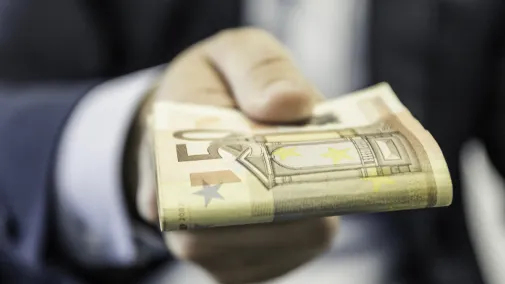
Secure banknotes are a matter of design
published on 25.08.2021
Establishing whether a banknote is genuine must be both fast and reliable. This is exactly what Adrian Heuberger has in mind when he designs new banknotes. In this interview, he talks about how new banknotes are designed and how they shape the identity of a currency area. He also explains which banknotes he finds particularly successful and the direction in which the international design trend is heading.
Security features only provide security if users actually understand them
How do you become a banknote designer? What special knowledge, skills and interests are useful and necessary?
Although there are number of ways to make a career in banknote design, I am not aware of any specific training institution. What all banknote designers have in common, however, is a delight in venturing into the microcosm of security design and a willingness to reconcile aesthetics with the highest technical demands. It is also important to understand that a lot of time and many work steps go into creating counterfeit protection.
What makes a banknote attractive? What messages should it convey?
A banknote must tell two stories. The first one is about the banknote itself, one that distinguishes it from other banknotes. The second one is about the family, the one the banknote belongs to when placed next to all the other banknotes in that currency. The design also needs to fulfil formal criteria in order to be pleasing to the eye. Take, for instance, the individual elements. Have they been beautifully designed and drawn with attention to detail? Do the colors blend well? Has the composition of the individual picture elements been carefully selected?
Which banknote design are you particularly proud of and why?
I am not primarily a designer, but a concept developer. That was also my role in the team working with Manuela Pfrunder in Zurich who designed my ‘favorite banknote’: the 200 Swiss franc note. She pursues the question of where we come from with enormous persistence and perseverance, literally going back as far as the Big Bang.
Is there a banknote that you did not design yourself that you consider particularly successful?
I like the former Dutch banknotes because of their very graphic and avant-garde patterns. I also like the Norwegian series where the reverse side of each banknote represents a pixelated version of the front side, creating a harmonious dialog between front and back.
How do you start to work on a banknote?
My first steps are of a purely idealistic nature. I read a lot and try to get a grasp of the cultural memory of a country or monetary union. This gives me important clues as to how a culture sees itself, but also raises questions, because nowadays practically every culture is pluralistic and eludes a homogenizing approach. From a design and conceptual point of view, however, these are in fact the really interesting questions. That’s why my next step is research to see how autochthonous, i.e., indigenous – artists answer these questions. In the end, I draw my very own personal inspiration for the story I want to try and tell in pictures. All in all, I always work in the digital and only rarely in the analog world.
How long does it take from the initial idea until a new banknote actually comes into circulation?
There is no one answer to that question. The process depends on a vast number of factors because many parties and entities are involved – not only in the concept and design. I have seen this take six months, but also as long as ten years. Especially when a security feature is applied for the first time, it is not uncommon to conduct a kind of technical and design-related ‘basic research’, although it must be said that technology and design are interdependent. The effect of a new type of security feature, for instance, always requires a design trial first as this is the only way to ensure that it is ideally positioned so that people can see and understand it.
Which departments at central banks and manufacturers are involved in the development of a banknote, and are other organizations also involved?
From the design department to the production department of the print shop, everyone is involved in the introduction of a new banknote. ATMs have to be retrofitted or reconfigured, administrative bodies issue the banknotes and put them into circulation. The communication department informs the public, for instance, through brochures and videos. All of these departments both at central banks and manufacturers are involved at some point.
How many rounds of approval are there in the end?
It can happen that you design an idea only for the decision-makers to reject it. That’s because sometimes they have to see an idea first to realize that it’s good but that it doesn’t work design-wise.
When designing banknotes, security is the top priority. To what extent does this influence the design process?
Security features only provide security if users really understand them. This is where design is needed. How should a security feature be designed so that its effect – such as a color change – can be perfectly captured? This is particularly important when explaining to people what they should look for when they check the authenticity of a banknote. The simpler the motifs, the easier they are for others to describe. It should also be possible for everyone to quickly find them on the banknote. What’s more, most security features have a certain ambivalence – it is not uncommon for them to have two states, for instance, because their color changes. Both states must be taken into account when describing what to look for when checking a banknote. Any additional ambiguity caused by motifs or their positions that are not easy to describe would be extremely counterproductive.
How can a banknote shape the identity of a nation or union of states?
I actually see a banknote as a surface on which identity can be projected. People automatically associate everything that is depicted on a banknote with what’s inside a country’s borders, such as culture, politics and society. In this way, a banknote can express and, in some cases, even influence a cultural identity. This also means that designers and concept designers bear a degree of responsibility that should not be under
How has your work changed in recent years?
I would say that expectations for a banknote design and the story told in images change in line with the natural changes taking place in a society. As far as the format is concerned, the international trend is to move from horizontal (landscape) format to vertical (portrait) format when designing a banknote, because this is considered to be more modern. Similarly, fewer countries are depicting portraits of famous people. The cultural identification offered should no longer come only from the past. Instead, the search is on for an identity that is anchored in the here and now. This is certainly not least due to the progressive pluralization and individualization of society. At the same time, I believe that banknotes are becoming more and more similar, no matter what country we are talking about. That’s because most states now want to portray their cultural diversity, their scientific location, their economic importance, their international relations as well as their humanitarian and ecological aspirations. You could say that the world of banknote design is akin to modern urbanism. People travel to cities in distant countries and encounter what they are already familiar with from home, i.e., there’s a McDonald's, a Starbucks and an H&M store.
What makes euro banknotes stand out from an aesthetic point of view? What was the main focus here?
All the buildings depicted on the euro notes are fictious buildings. If they were real, then their geographical location would also have been real: Each of them would have a geographically clearly identifiable location in one of the 27 member states today. But since there are fewer different euro banknotes than member states, this would have led to some countries being favored while discriminating against others, and certainly disastrous for a banknote concept that ultimately aims to accentuate cohesion.
Payment behavior is changing, and electronic means of payment is rapidly become more important, especially abroad. Can you imagine a world without cash?
Even today, the majority of all transactions are intangible, i.e., they have no counterpart in physical reality. This leads directly to another question: Does the fact that the world continues to turn without cash have implications for the answer to the question of what money is? I would say: yes. After all, if the world can work without cash, then we can say that money is more than just cash. Money also works without the physical equivalent of a banknote, i.e., purely intangibly. And it may even be that intangible money is the more honest money.
What do you mean?
The essence of money is defined by the fact that it has no boundaries. Money can buy – almost – everything. It breaks down the boundaries that are set against it. This means that it cannot be forced into the corset of something tangible. You could also argue that money that has shed its tangible form, i.e., electronic means of payment, does more justice to the very essence of money. To put it more pointedly, the less tangible money is, the more it becomes money. Money is so abstract that it is equal to nothingness. Surprisingly, however, it is precisely this nothingness that performs a useful service in measuring the value of things and trading in them.





